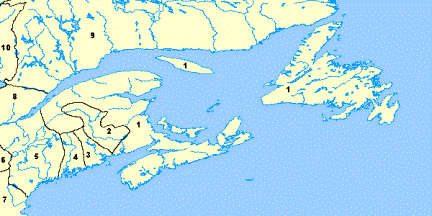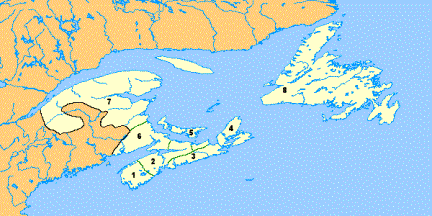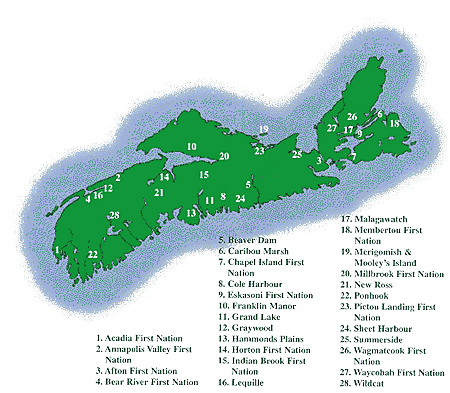
3.1 Nation
The Mi`Kmaq are a part of the Wabanki Confederacy who are The People Of The Dawn. The tribes include The Mi`Kmaq, Maliseet, Passamaquoddy, Penobscot, Abenaki, Sokoki, Pennacook, Algonkin, Montagnais/Naskapi, and the Cree people who live on the Northeastern seaboard of Turtle Island now known as North America.Please refer to the map below in figure 1.0 to see the geographical relationship of these Nations.

Figure
1. The map above illustrates the geographical territory of the Mi'Kmaq
and neighbouring tribes on the Northeastern seaboard of Turtle Island
now known as North America. The
numbers represent the following Nations: (1) Mi'Kmaq, (2) Maliseet, (3)
Passamaquoddy, (4) Penobscot, (5) Abenaki, (6) Sokoki, (7) Pennacook,
(8) Algonkin, (9) Montagnais/Naskapi, (10) Cree.
Source: http://www.mikmaq.net/english/territory/neighbours.html
3.2 Territory
Mi`Kmaq territory included all of the Atlantic Provinces and down into the New England states including the small islands. The territory was divided up into seven areas throughout the Atlantic coast and each called a sakamowit. Sakamowits represent traditional hunting grounds of Mi'Kmaq Bands throughout Nova Scotia. Figure 2 illustrates the seven sakamowit of megumaage (Mi`Kmaq territory).
Names and meanings of the sakamowit of megumaage are:
KESPOOGWITUNAK. (lands end) (Acadia Band, Bear River Band, Annapolis Valley Band, Horton Band.)
ESKEGAWAAGE. (skin dressers area) (Afton Band.)
OONAMAAGIK. (land of fog) (Chapel Island Band, Eskasoni Band, Membertou Band, Wagmatcook Band, Whycocomagh Band.)
SIGUNLKTAWAK. (drainage area) (Big Cove Band, Buctouche Band, Fort Folly Band, Indian Island Band.)
EPEKWITK ADD PIKTUK. (laying in the water and the explosive area) (Pictou Landing Band, Lennox Island Band, Abegweit Band.)
KTAQMKUK. (far shore over the waves) (Bartletts Harbour Band, Benoit's Band, Corner Brook Band, Exploits Band, Flat Bay Band.)
KESPEKEWAQ. (last land) ( Aroostook Band, Burnt Church Band, Eel Ground Band, Eel River Band, Gesgapegiag Band, Gaspe Band, Listuguj Band, Pabineau Band, Red Bank Band.)
Each geographical district or (sakamowit) set up by the Mi`Kmaq in the Atlantic coast, had a traditional chief and under him or her representatives from the different clans that made up the district.
Meetings of the seven areas would be held in various areas depending upon the issues to be discussed. These might range from war with other tribes to encroachment upon hunting and fishing territory.The main talks would be around the availability of fish and game in the different areas.If the clan leaders reported lack of fish or game in their area they would be assigned a different area to move to and live where the fish and game was plentiful.
Meetings were held often during the encroachment of the European.The arrival of these foreign people brought concern to the Mi'Kmaq about starvation due to European people depleting the surrounding resources by the clearing of land for agriculture and export of trees, and extensive harvesting of fish and game. Mi'Kmaq were concerned about these activities diminishing their territory and this led to confrontation with the settlers.
Eventually meetings were held to enter into the treaties which hunting and fishing rights and territories were affirmed while keeping peace with the settlers.

Figure 2. The map above depicts the territory of the Mi'Kmaq Nation.The territory includes all of the Atlantic Provinces and down into the New England states including the small islands. The territory was divided up into seven districts (sakamowits). The numbers represent the following sakamowit: (1) Kespoogwitunak, (2) Sikepnekatik, (3) Eskegawaage, (4) Oonamaagik, (5) Epekwitk Add Piktuk, (6) Sigunlktawak, (7) Kespekewaq, (8) Ktaqmkuk.
Source: http://www.mikmaq.net/english/territory/sakamowitk.html
3.3 Mi'Kmaq Communities in Nova Scotia
The Mi'Kmaq in Nova Scotia have several communities throughout the province, these are illustrated in figure 3. The Afton Band is located in eastern Antigonish County and is composed of Pomquet-Afton, Franklin Manor and Summerside, given as number 3 in figure 3.

Figure 3. Mi'Kmaq communities in Nova Scotia.
Source: http://accesswave.ca/~mtsack/graphics/nsmap2.gif
3.4 The Mi`Kmaq Model Of Governance<
The knowledge of the First Nations remains primarily in their indigenous worldviews, language, and the rituals. Worldviews are holistic constructs in which the past, present, and future, and the environment are interwoven. This worldview can be symbolized as a medicine wheel, in which the four responsibilities translate as peace, kindness, sharing, and trust.
The governing system of the Mi`Kmaq, a natural order with a well -defined system of consensual government.It included both an intertribal and tribal law. Mi`Kmaq order was built upon sources upward from the family unit rather than the downward monarch state.
The Grand Council consisted of seven hunting districts comprising the national territory, roughly forty thousand square miles which extends from Newfoundland, to Quebec, andNorthern Maine. The Grand Council was bound together by councils, held at all levels of Mi`kmaq society, from the local family to the extended families at the regional levels (Young and Metallic 1999).
The initial confederation among the Mi`kmaq was called awitkatultik (many families living in one house). This confederation was comprised of six districts (sakamowti), and later other districts were added. Each district was made up of the extended families and was guided by the Sakamow. The Sakamow (or district chief) had collective responsibilities along with the 'saya' (leaders of the extended families) and 'kaptins' (community spiritual leaders), to guide districts in all matters. These leaders and heads of families, created order and continuity in governance. According to oral tradition everyone participated in all decisions of the 'wikamou', the regional and local councils. Within each district the local family council was the basic unit of government, administering the justice system. The 'wikamou' met every night except during harvest and would make decisions based on consensus. In this sense everyone could speak and every family and Mi`kmaq had the right to participate (Young and Metallic 1999).
Mi`Kmaq customs and rituals fostered vigorous discussions and if consensus could not be reached then 'wikamou' custom required withdrawal from the debate to promote harmony.The district Chiefs and there families formed one national council. The role of this is to advise and defend the people. Like district and local councils the Mawiomi is a deliberative body, without powers to legislate or adjudicate. The task of the mawiomi is to facilitate consensual decisions across district and families. The Mi`kmaq respected the binding obligation only if derived from consent. To the Mi`kmaq sovereignty was about resolving difficulties rather than avoiding them. The Mawiomi sought consensus on policy and conciliation on regional strategies. Every three to seven years the council would review its polices. The Mawiomi deliberations were led by any two elected heads of states: the Kjisakamou(Grand Chief), and the spiritual leader Kijkaptin (Grand Kaptin). These leaders guided discussions and implemented consensus. Leaders were chosen based on qualities exemplified such as courage, kindness, generosity, wisdom, and even temper. The families or clans were the managers of unity not the Sante Mawiomi (Young and Metallic 1999).
Oral tradition taught that the key to understanding their domestic law was kindness, with an emphasis on empathy. Mi`Kmaq customary law was a subtle and complex normative order, where the flux was the universal norm and as such there was no noun -based system of positive law. In the view of the Mi`Kmaq, to freeze their understanding into rules that undermine processes would not be in balance with their way of life (Young and Metallic 1999).
No individual could declare the customary rituals and solutions. Rules were developed through local solutions based on the experience and consensual understanding. Customary laws were guidelines developed from example or values of conduct taught in a family setting, and kept in a form of life values rooted in spiritual force. Its standards were neither universal nor enforced by man-made institutions. Initiating the process was a family responsibility, remedy was a clan function. The Mi`kmaq believed that orderly process presupposed and evoked balance in the soul and the environment. Harmony was perceived as being derived from awareness, participation, kinship education, and continuing rituals. The emphasis of the process was on self control or discipline, rather than authority from above, or competition. Responsible behavior was rewarded with honor, respect, and solidarity. Aggressiveness of any sort threatened violence and required human mediation.The distinguishing mark of a person was their ability to withdraw from conflict and to think good thoughts. Coercive law by an artificial institution was generally absent, if not vigorously opposed. In regards to disputes all offences and quarrels were adjudicated with and between families. The essential principle of customary law was that controversies should be prevented. Harmony, not justice was the ideal. Kinship pressure pushed to find the quickest solution and to find harmony (Young and Metallic 1999).
Also in Mi`Kmaq law the operative concept was shared liability within one's extended family, rather than personal liability. Causation, not guilt, was shared equally by ones family and the forces of the environment. By making the whole family responsible for its actions of its members encouraged everybody to behave properly and thus create a caring society. Collective responsibility increased certainty in the management and behavior and harmony. When conflict arose the offending, family made peace by offering gifts and other suitable attunements. The offended family had a right to retaliate and the offenders' family had a duty to remain faithful to harmony and stoically remain indifferent to the conflict. Punishment was not the direct responsibility of the Mawiomi or general council (Young and Metallic 1999).
Extended families could renounce its collective responsibility for a member if one was not fulfilling their obligations. Even personal revenge was not an individual matter, rather it had to be submitted to the government, the family unite, for remedy. Rights, responsibilities, and their impact on the general state of the nation determined citizenship. Historically, the policy to renounce one's membership was simply to exile or banish the individual or family.
The Mawiomi meaning of shared space was interpreted by families who would meet yearly and talked about the past years hunting and gathering and based the allocation of the resources among themselves for the current year. One family usually managed the resources for the band of families and decisions were based on the carrying capacity of the allotted hunting district. The allocation of land to hunt may mean that the families would have to move to a different area of land to hunt and gather letting the other to regenerate. This management of resources was guided by intertribal customary trading code within the realm of Nikmanen Law (Young and Metallic 1999).
The focus of sharing resources is parellel to the focus of consensus in creating government structures and space mediation in family law, In this sense the users of the resources are simply managers of shared property, council are the managers of shared power, and the families are managers of shared responsibilities for their members' behaviour. Maintaining harmony in a fragile ecosystem required proper human behavior and thus helped prevent the waste of resources. Everything had to be used to its full capacity and purpose (Martin 1978).
The Mi`kmaq Compact illustrates the concept of sharing and exchanging of gifts, which was the fundamental premise of their concepts in ecology, social structure, and property. The treaties created boundaries for communal and autonomous law thereby insulating reserved lands and British settlements. They also created an integral system of mutual obligations and responsibilities.
The 1726 Accession to the Wabanaki Compact and 1752 Mi'Kmaq Compact acknowledged laws of peace and harmony critical to the Mi'Kmaq way of life. When these laws collided with English 'Law' the alternative for the Mi`Kmaq was to withdraw and disassociate from the conflict, thereby maintaining peace and harmony, and allowing for civil remedy. The terms of these compacts and treaties affirmed the First Nations' capacity to maintain legal autonomy and dual jurisdiction. Neither community could presume to impose a unilateral legal system on the other. Each community had the liberty and capacity to interpret their space and to encourage harmony between the two cultures (Young and Metallic 1990).
In the Algonquian way, the law of the tribes is built on consensual agreement not family structures. This alliance is a matter of trust in the given word to each other. When the Mi`Kmaq entered into war or to enforce customary law Nikmanen Law was not meant to negotiate peaceful agreements but rather to maintain a peace based on mutual trust, harmony and honor. Under Nikamanen Law, a war parties victory required the winner to have a (give away) and feast to share with the losing party. Both would acknowledge the reality that both had broken their word to each other thus leading to the resolving of the disagreement and reestablishment of the trust leading to peace and harmony. Like domestic law, Nikmanen law did not view aggression as justifiable, even if it is unavoidable. Peace and harmony were the norms therefore, self-discipline and forgiveness had to include the giving of presents and satisfactions after military raids to encourage good thoughts and feelings (Young and Metallic 1990).
The Mi`Kmaq Compact of 1752 illustrates the tenacity for Mi`Kmaq to apply their customary doctrine of forgiveness to a different normative world. Treaties such as the Compact, according to Mi`Kmaq people are living agreements rather than mere documents, one cannot assume that peace and friendship were maintained without being visually displayed and acknowledged and thus subject to renewal ceremonies of subsisting relationships. For this reason, treaties were held in high regard and were sacred because it represented the honor and word of the leaders to the tribal Nations. Treaties create shared responsibilities and accountabilities rather than supreme powers. Treaties were not meant to establish a centralized regulatory body over Indians and reservation lands for Indians.